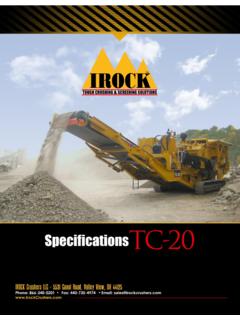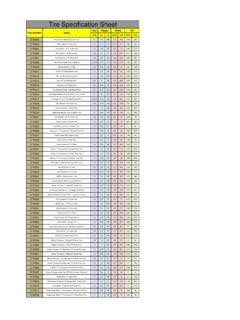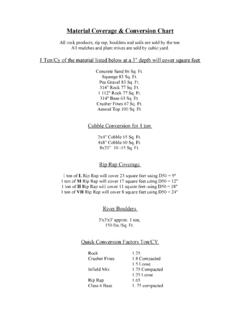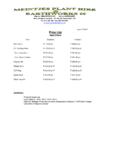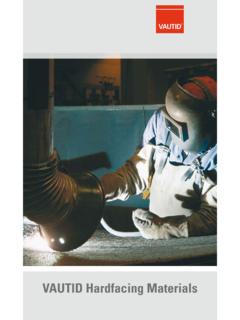Transcription of SEPTEMBER 2011 TECHNICAL NOTE Use of Recycled …
1 Keeping victorians connectedSEPTEMBER 2011 Use of Recycled Materials for Road ConstructionTECHNICAL NOTE 107 Recycled concrete, basalt spalls, asphalt, glass and brick, processed to meet specification requirements, provide suitable materials for roadworks applications, and also for path and drainage construction, saving on use of natural last decade has seen a significant expansion in the availability and quality of Recycled materials for use in road building. As pavement materials predominantly consist of crushed rock and aggregate there is significant opportunity to utilise alternative materials incorporating Recycled products. This TECHNICAL Note is intended to provide guidance in the use of Recycled materials in pavement works as an alternative to the use of conventional materials produced directly from quarried sources.
2 SUSTAINABILITYW hile Victoria s geology is favourable and provides plenty of high quality rock (Figure 1), accessible sources are becoming very limited. The ever increasing public demand for residential land and associated environmental constraints have meant the establishment of new metropolitan-based hard rock quarries or extensions to existing quarries are now very costly and time consuming to achieve. Hence, metropolitan or urban sources of quarried product is finite. Furthermore, local sources are needed to minimise cartage costs. High cartage costs make construction more expensive when quarry products are transported into the metropolitan area from distant regional sources. Transporting materials over long distances also add significantly to the carbon footprint of road construction and increase road wear.
3 Figure 1: Hard rock quarryAlternative materials to supplement the use of virgin quarry rock exist in Melbourne. Currently, there are steady supplies of Recycled materials such as crushed concrete, Newer Basalt surface spalls (NBSS), crushed brick and reclaimed asphalt pavement (RAP). Combined with good processing facilities there is significant opportunity to utilise these materials in pavement Recycled materials in appropriate applications can contribute significantly towards making prime non-renewable rock resources last longer. This is particularly important for applications where virgin hard rock cannot currently be specifications allow a range of Recycled product, supplied from sources accredited by vicroads in accordance with vicroads Code of Practice for Source Rock Investigations, to be utilised in road pavements.
4 Recycled product includes water, surface spalls, crushed concrete, RAP, crumbed rubber, and crushed brick, tiles, glass and whitewares. The two most commonly used Recycled materials as alternatives to granular material are crushed concrete and RAP. These and crushed glass fines material are discussed in further detail ConcreteRecyclable concrete often becomes available from demolition works and other construction activities (Figure 2).During processing of recycleable concrete, steel and other contaminants are removed as necessary, and crushing and screening produces a graded road-making material. In recent years, Recycled crushed concrete (Figure 3) has been produced (currently up to 2 million tonnes annually) and supplied to a wide range of road applications, including the stabilised subbase of various sections of the Western Ring Road, where past practice would have been to use traditional quarried rock products.
5 Crushed concrete by definition is composed of rock fragments coated with cement, with or without brick, sands and/or filler, produced to comply with tolerances for grading and minimum foreign material content, and supplied at a lower density than that for crushed igneous rock. TECHNICAL NOTE - NO. 1072 Figure 2: Reclaimed concrete for crushing, screening and removal of contaminantsFigure 3: Crushed concreteVicRoads Standard Section 820 Crushed Concrete for Pavement Subbase and Light Duty Base covers the requirements for the manufacture of Recycled crushed concrete and plant mixed wet-mix crushed concrete products. vicroads Standard Section 821 Cementitiously Treated Crushed Concrete for Pavement Subbase covers the requirements for 20 mm nominal size crushed Recycled concrete or crushed rock/concrete blends for pavement subbase, treated with cementitious binder to produce a bound Asphalt PavementMilled or excavated asphalt pavement, known as RAP, obtained from the road and other sources can be collected as a co-mingled stockpile (Figure 4), processed by crushing and screening to a graded material, free of contamination, ready for use in new asphalt manufacture.
6 It is estimated that about 200,000 tonnes of RAP is used annually in Standard Section 407 Hot Mix Asphalt permits processed RAP (Figure 5) to be added to most dense grade asphalt mixes. The maximum allowable amount of RAP to be added depends on the mix type and the loading and service conditions. Generally, a lesser amount of RAP is permitted in mixes used for high stress locations. Figure 4: Reclaimed asphalt for crushingFigure 5: RAP after processingThe specification also provides an opportunity for the amount of RAP to be increased by up to 10% (by mass) over the specified limits for numerous asphalt types. This is provided that comparative performance tests are carried out to show that the RAP mix has equivalent performance characteristics to the corresponding mix manufactured wholly from virgin Glass FinesGlass fines are manufactured from container glass cullet, by removing contamination and crushing and grading to a 5 mm cubical product.
7 Glass fines can be added to some crushed granular products and to some non-wearing course asphalt mixes in proportions as detailed in the relevant product registered mix fines are able to met the requirements for some granular filter materials in vicroads Standard Section 702 Subsurface Drainage. 3 TECHNICAL NOTE - NO. 107 PAVEMENT APPLICATIONSP avement materials, including those containing reclaimed or Recycled material, must have properties that provide the required service life of the pavement. The degree to which each layer of pavement material should have these properties depends on the position the layer will occupy in the pavement. The intensity of stresses from traffic loads reduces significantly with depth below trafficked level, and the quality of the material in terms of bearing capacity may also decrease for each successively lower layer of pavement.
8 The materials in the lower layers may be selected for economy, for example to include proportions of reclaimed or Recycled material, to conserve higher quality resources for better use. However, the lower layers must still be sufficiently durable to resist degradation during the design life of the OF MIXC rushed granular mixes incorporating Recycled materials must be registered in accordance with vicroads Code of Practice Registration of Crushed Rock Mix Designs prior to use on any vicroads mixes must be registered in accordance with vicroads Code of Practice Registration of Bituminous Mix Designs prior to use on any vicroads mix designs registered with vicroads are issued a status according to their level of compliance with the vicroads Code of Practice or the specification.
9 General indicates the mix complies with the requirements of the Code of Practice, and Conditional indicates the mix does not comply in all respects (for example, material type) with the requirements of the Code of Practice but which is considered appropriate for use subject to conditions attached (for example, testing frequency, traffic loading) to the USE GUIDANCE MATRIXT able A Guidance Matrix for Road Construction Materials provides guidance on how Recycled material can be used as an alternative to conventional quarried products. It also outlines permissible additions of supplementary materials to Recycled materials and notes the applicable vicroads Standard Specification matrix has been prepared as a guide in the consideration, selection and use of Recycled materials as alternative to conventional materials in appropriate situations.
10 Road construction materials can also include components of Recycled materials as allowed by vicroads specifications. Such materials can offer savings to the project through density, environmental and pricing benefits. vicroads requirements, as appropriate, for source accreditation, mix registration, placement, compaction, testing and frequency of testing must be vicroads Standard Specification Section 820 Crushed Concrete for Pavement Subbase and Light DutyBase 2. vicroads Standard Specification Section 821 Cementitiously Treated Crushed Concrete for Pavement Subbase3. vicroads Standard Specification Section 407 Hot Mix Asphalt4. vicroads Standard Specification Section 702 Subsurface Drainage5. vicroads Code of Practice Source Rock Investigations6.
